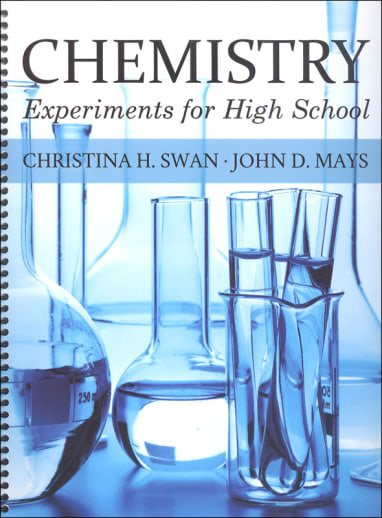Written as the lab manual to accompany Novare’s General Chemistry and Chemistry for Accelerated Students, the Chemistry Experiments for High School works best in a fully outfitted laboratory with standard equipment. The Manual includes full procedural and safety instructions, material lists, and discussion questions for 20 experiments, along with instructor notes. Those wanting to include experiments for the Novare Chemistry courses at home or in a small private facility without full equipment, should consider Chemistry Experiments for High School at Home.
Chemistry Experiments for High School
Product Overview
- Rigorous program with accelerated scope and sequence, and course pacing
- Physics and Algebra 1 are prerequisites; Algebra II should be taken concurrently
- Program materials included are the Chemistry for Accelerated Students Textbook, Solutions Manual, Digital Resources, and the Chemistry Experiments for High School at Home
- Digital Resources include a course overview, quizzes, chapter and semester assessments, and all related answer keys. It also includes a lessons list, and sample calendar and graded lab report
Description
A laboratory practicum incorporating a series of quantitative experiments is an essential component of any high school or college chemistry course. It is one thing to read about precipitations; it is another thing to see the precipitates form with your own eyes. Lab experience also provides students with practice using standard laboratory apparatus and methods. Finally, there is nothing like laboratory practice to give students a feel for how the stoichiometric calculations learned in the classroom relate to the predictions and results of an actual experiment
This manual is the student's guide to accompany General Chemistry and Chemistry for Accelerated Students. Included are instructions for 20 experiments, materials lists, safety issues, discussion questions and more. Pages are perforated for easy removal of the Short Form Report Sheet which is to be filled out and turned in after each experiment.
The experiments in this manual are designed for schools with standard laboratory facilities and equipment. If your school or home does not yet have such facilities, we suggest you take a look at our other experiments book, Chemistry Experiments for High School at Home (CEHSH). The experiments in CEHSH are rigorously quantitative, just as they are in CEHS.
For chemistry, or any high school science experiment, we recommend The Student Lab Report Handbook as a companion guide to show students how to prepare excellent lab reports.
Intended for use at the 11th grade level, Novare General Chemistry takes a bit of a different approach from other chemistry courses. Focusing on fewer topics with more depth, Novare Science takes a Kingdom Perspective to current scientific theories. Prior to the course, students should have successfully completed Algebra 1, Introductory Physics and Biology. Algebra 2 should be taken concurrently. By following the author's suggestion of physics first, the student can more easily work through General Chemistry and have a greater understanding of the concepts. Through General Chemistry, students are brought into the real world of chemistry through detailed and clearly explained text, laboratory experiments, and carefully constructed exercises and quizzes. The history of modern chemistry, mathematics and technical communication is emphasized throughout.
Typically, you need a lab component with chemistry courses. No labs are included in the Student Text, so the author recommends Chemistry Experiments for High School at Home for those who are homeschooling. This book has low-cost alternatives to expensive equipment and recommendations for procuring small quantities of chemicals. Optional and helpful resources include the Student Lab Report Handbook and the optional Lab Kit. Required components include the Student Edition Text, Digital Resources, Complete Solutions and Answers, and the Chemistry Experiments for High School at Home to meet the lab requirements on your high school transcript. Available separately or as a convenient package for the full Program.
| Product Format: | Paperback |
|---|---|
| Grades: | 11-12 |
| Brand: | Novare Science and Math |
| ISBN: | 9780990439769 |
| Length in Inches: | 11 |
| Width in Inches: | 9 |
| Height in Inches: | 0.875 |
| Weight in Pounds: | 1.1 |

